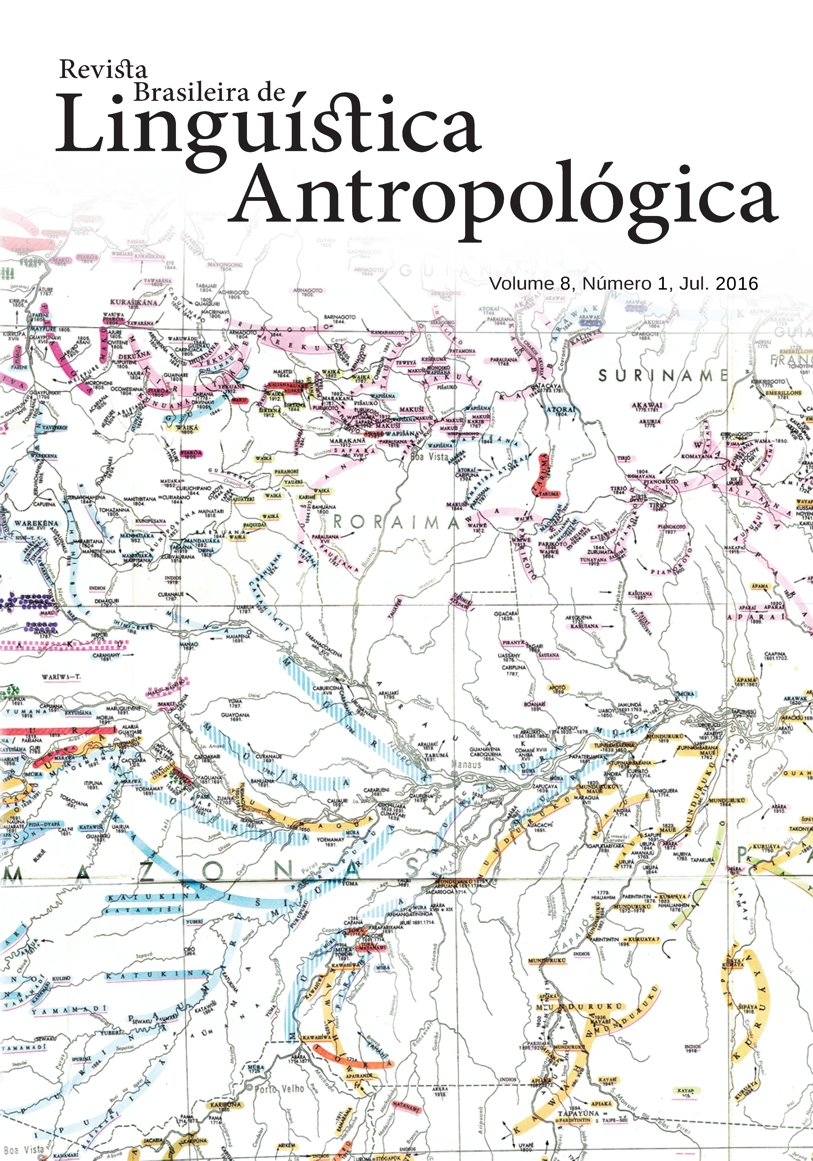Antipassive structure in Tenetehára (Tupi-Guarani family)
DOI:
https://doi.org/10.26512/rbla.v8i1.16311Palabras clave:
LinguísticaResumen
This article aims to describe and examine the antipassive construction in the Tenetehára language (Tupi-Guarani family). For this, it will be shown that the transitive verbs, on receiving the morpheme {puru-}, then exhibit the following properties of antipassive constructions: (i) they come to have an intransitive syntactic structure and (ii) the abstract Case of the internal argument is not valued by v, but by the postposition -ehe. Generally, such configurations behave essentially like intransitive sentences. Using a minimalist approach, we show that the main difference between an antipassive clause and a transitive one is that although the antipassive vP selects an external argument, its head is not able to value the abstract Case of the internal argument. For this reason, the object is dependent on the postposition -ehe for the oblique Case. Furthermore, unlike what happens in the derivation of transitive constructions, the φ-feature of the antipassive vP is lexically valued, which does not allow the agreement (nominative system) in terms of φ-feature, with its external argument. The result is that this external argument moves to the highest vP Spec position in the tree structure, whose head is instantiated by the verb {-wer} “want”, with which it establishes a relationship agreement in terms of φ-feature , triggering the second agreement paradigm (absolutive system).Referencias
Aldridge, E. 2012. Antipassive and ergativity in Tagalog. Lingua: 122(3):192-203.
Baker, M. C. 1988. Incorporation: a theory of grammatical function changing. Chicago: University of Chicago Press.
Bittner, M. 1987. On the semantics of the Greenlandic antipassive and related constructions. International Journal of American Linguistics 53:194-231.
Blight, R. C. 2004. Head Movement, Passive and Antipassive in English. Ph.D. dissertation, UT, Austin, TX.
Camargos, Q. F. 2010. Para onde foram os adjetivos em Tenetehára? Monograph, UFMG, Belo Horizonte, MG.
Camargos, Q. F. 2015. Exploring agreement displacement from the IA to the EA in the Tenetehára language (Tupí-Guaraní). In Handout of the Talk, July 1, 2015, GTTG da Anpoll. Universidade Federal de Minas Gerais, Belo Horizonte.
Castro, R. C. 2013. O epifenômeno da alternância de valência na língua Tenetehára (Tupí-Guaraní). Revista da Anpoll 34:347-391.
Chomsky, N. 1995. The Minimalist Program. Cambridge: The MIT Press.
Chomsky, N. 2005. Three factors in language design. Linguistic Inquiry 36:1-22
Cooreman, A. 1994. A functional typology of antipassive. In Voice: form and function, ed. B. Fox, P. Hopper, 49-86. Amsterdam: John Benjamins Publishing.
Dixon, R. M. W. 1979. Ergativity. Language 55:59-138.
Dixon, R. M. W. 1994. Ergativity. Cambridge: Cambridge University Press.
Duarte, F. B. 2005a. Propriedades denotacionais dos prefixos {i-} e {h-} em Tenetehára. Revista Estudos Linguísticos 34:1194-1199.
Duarte, F. B. 2005b. Codificação de argumentos e ergatividade (cindida) em Tenetehára. Revista LIAMES 5:111-142.
Duarte, F. B. 2007. Estudos de morfossintaxe Tenetehára. Belo Horizonte: FALEUFMG Press.
Duarte, F. B. 2012. Tenetehára: a predicate fronting Language. The Canadian Journal of Linguistics 57(3):359-386.
England, N. C. 1988. Mam Voice. In Passive and Voice, ed. M. Shibatani, 525-545. Amsterdam: John Benjamins Publishing.
Givón, T. 1993. English Grammar: a functional-typological introduction. Amsterdam: John Benjamins Publishing.
Harrison, C. 1995. The interplay of causative and desiderative in Guajajara. Revista dos Cursos de Pós-Graduação em Letras 4:83-114.
Nolasco, R. 2009. What Philippine ergativity really means. Baguio: University of the Philippines.
Palmer, F. R. 1994. Grammatical Roles and Relations. Cambridge: Cambridge University Press.
Polinsky, M. 2005. Antipassive constructions. In The World Atlas of Language Structures, ed. M. Haspelmath, M. S. Dryer, D. Gil, B. Comrie. Oxford: Oxford University Press.
Rodrigues, A. D. 1985. Relações internas na família lingüística Tupí-Guaraní. Revista de Antropologia 27/28:33-53.
Rodrigues, A. D. 1990. You and I=neither you nor I: the personal system of Tupinambá. In Amazonian linguistics: Studies in lowland South American languages, ed. D. L. Payne, 393-405. Austin: University of Texas Press.
Silverstein, M. 1976. Hierarchy of features and ergativity. In Grammatical categories in Australian languages, ed. R. M. W. Dixon, 112-171. New Jersey: Humanities Press.
Spreng, B. 2001. Little v in inuktitut: antipassive revisited. Linguistica atlântica 23:155-190.
Wurmbrand, S. 2011. On Agree and Merge. Storrs: University of Connecticut.
Wurmbrand, S. 2012. Parasitic participles: evidence for the theory of verb clusters. Taal en Tongval, 64:129-156.
Wurmbrand, S., 2013. The features of voice. In: Handout of the Talk, October 26, 2013, Little v Workshop. Leiden University, Holland.
Descargas
Publicado
Número
Sección
Licencia
Derechos de autor 2017 Revista Brasileira de Linguística Antropológica

Esta obra está bajo una licencia internacional Creative Commons Atribución 4.0.
Los autores que publican en RBLA aceptan los siguientes términos:
a) Los autores conservan los derechos de autor y otorgan a la revista el derecho de primera publicación, y el trabajo se licencia simultáneamente bajo la Creative Commons Attribution License, que permite compartir el trabajo con reconocimiento de la autoría del trabajo y la publicación inicial en esta revista. .
b) Se autoriza a los autores a asumir contratos adicionales por separado, para la distribución no exclusiva de la versión del trabajo publicado en esta revista (por ejemplo, publicar en un repositorio institucional o como capítulo de un libro), con reconocimiento de autoría y publicación inicial en este diario.
c) Se permite y se anima a los autores a publicar su trabajo en línea (por ejemplo, en repositorios institucionales o en su página personal) en cualquier momento antes o durante el proceso editorial, ya que esto puede generar cambios productivos, así como incrementar el impacto y la citación de el trabajo publicado.










